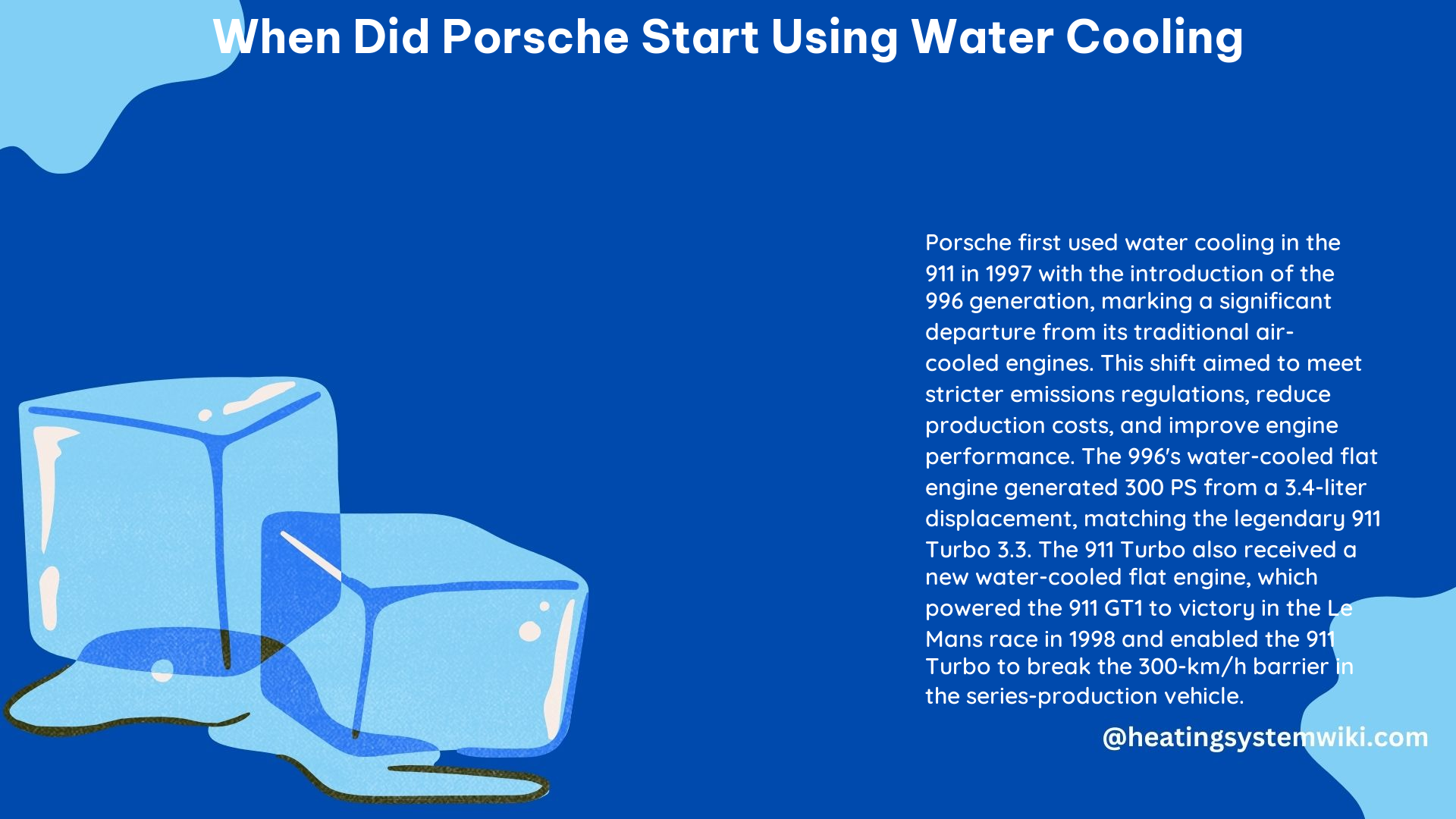Porsche, the iconic German automaker, has a rich history of engineering excellence, and the transition from air-cooled to water-cooled engines in its road cars is a significant milestone. This comprehensive guide delves into the details of when Porsche started using water cooling, the technical specifications of their water-cooled engines, and essential DIY tips for maintaining these sophisticated systems.
Porsche’s Foray into Water Cooling
Porsche’s journey with water-cooled engines began in the 1980s, with the introduction of the 924, 944, and 928 models. These cars marked the first time Porsche used water cooling in their road cars, a departure from the brand’s long-standing tradition of air-cooled engines, which had been a hallmark of the iconic 911 since its inception in 1964.
However, the true watershed moment came in 1998 with the launch of the Porsche 996 Carrera, the first fully water-cooled production Neunelfer (the internal designation for the 911). This move was a significant departure from Porsche’s air-cooled heritage and was driven by the need to meet increasingly strict emissions regulations and improve engine performance.
Porsche’s Water-Cooled Racing Experiments

Prior to the introduction of water-cooled engines in their road cars, Porsche had been experimenting with the technology in their racing cars. One notable example is the Porsche 935/78 ‘Moby Dick’ from 1978, which featured water-cooled cylinder heads. The 959 supercar, launched in 1986, also had water-cooled cylinder heads, and the 962C sports prototype, which won the 24 Hours of Le Mans in 1986 and 1987, used a fully water-cooled flat-six engine.
These racing experiments paved the way for the eventual adoption of water cooling in Porsche’s road cars, as the company sought to leverage the performance and efficiency benefits of the technology.
The M96 and Mezger Engines
The water-cooled engine that debuted in the Porsche 996 Carrera was known as the M96. This engine had a displacement of 3.4 liters and generated 300 PS (221 kW). After a subsequent engine facelift, the displacement increased to 3.6 liters, and the power output rose to 320 PS (235 kW). In the anniversary edition “40 years of Porsche 911,” the power output even reached 345 PS (254 kW).
Another notable water-cooled engine used in Porsche’s road cars is the Mezger engine, which was employed in the 996 GT3 and Turbo models. This engine was based on the water-cooled unit used in the 962C sports prototype. The naturally-aspirated version of the Mezger engine had an output of 360 PS (265 kW), while the twin-turbocharged version could produce up to 483 PS (355 kW).
DIY Tips for Water-Cooled Porsche Maintenance
Owning a water-cooled Porsche requires a different approach to maintenance compared to the air-cooled models. Here are some essential DIY tips to keep your water-cooled Porsche running at its best:
-
Check the Cooling System Regularly: Water-cooled Porsches have a complex cooling system that needs to be inspected regularly for leaks and other issues. Regularly check the coolant level, hoses, and radiator, and replace any worn or damaged components as needed.
-
Use the Correct Coolant: Porsche recommends using a specific coolant, known as G12 or G13, in its water-cooled engines. Using the wrong coolant can lead to corrosion and other problems, so be sure to use the correct coolant and follow the recommended maintenance schedule.
-
Upgrade the Cooling System: If you plan to track your water-cooled Porsche, consider upgrading the cooling system to handle the increased heat and stress. This may include upgrading the radiator, intercooler, and other components to improve cooling and reduce the risk of overheating.
By following these DIY tips and understanding the technical specifications of Porsche’s water-cooled engines, you can ensure your water-cooled Porsche remains in top condition and continues to deliver the performance and reliability that the brand is known for.
References:
- Porsche has been building water-cooled 911s for 25 years now. (2022-12-11). Retrieved from https://www.motorauthority.com/news/1138083_porsche-has-been-building-water-cooled-911s-for-25-years-now
- Water-cooling: A Porsche 911 history – Total 911. (2016-05-10). Retrieved from https://www.total911.com/water-cooling-a-porsche-911-history/
- The 996: First 911 with water-cooled flat engine. (2018-11-25). Retrieved from https://www.porsche.com/usa/aboutporsche/pressreleases/pag/?id=520649&pool=international-de
- The 996: First 911 with water-cooled flat engine – Porsche Newsroom. (2018-11-25). Retrieved from https://newsroom.porsche.com/en/history/porsche-911-seven-generations-part-5-typ-996-16487.html
- Whats the hype with air cooled and liquid Porsche 911s? – Reddit. (2023-05-10). Retrieved from https://www.reddit.com/r/cars/comments/13dptky/whats_the_hype_with_air_cooled_and_liquid_porsche/
